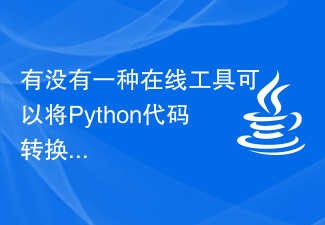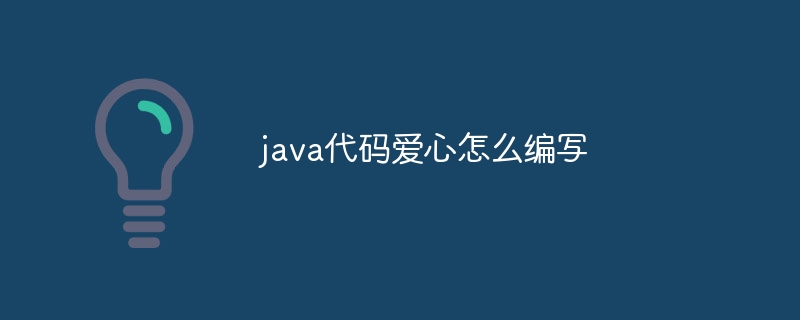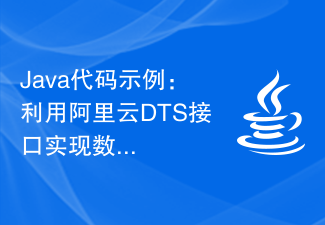 Java
Java javaTutorial
javaTutorial How to use Java code to implement dragging map events on Baidu Map and obtain the longitude and latitude of the current map center point?
How to use Java code to implement dragging map events on Baidu Map and obtain the longitude and latitude of the current map center point?How to use Java code to implement dragging map events on Baidu Map and obtain the longitude and latitude of the current map center point?
Map applications are a common function in modern life. We often use maps to find routes, locate locations, etc. Baidu Map is one of the most commonly used map applications in China. It provides a rich API interface so that developers can integrate map functions into their own applications.
In this article, we will introduce how to use Java code to implement dragging map events on Baidu maps and obtain the latitude and longitude of the current map center point. First, we need to prepare some necessary resources. Please make sure you have registered a Baidu Maps developer account and obtained the corresponding developer key (ak).
Next, we will use Baidu Map’s Java SDK. The specific steps are as follows:
Step 1: Introduce Baidu Map Java SDK
First, we need to introduce Baidu Java SDK for maps. Add the following dependencies in the project's pom.xml file:
<dependencies>
<dependency>
<groupId>com.baidu</groupId>
<<artifactId>baidu-map-java-sdk</artifactId>
<version>3.0.0</version>
</dependency>
</dependencies>Step 2: Create a map object
In Java code, we need to create a map object in order to operate the map. We can use the BaiduMap class to create a map object. The code example is as follows:
BaiduMap baiduMap = new BaiduMap();
Step 3: Set up the map event listener
In order to implement the drag map event, we need Set up a map event listener. In this listener, we can handle the map drag event and obtain the latitude and longitude of the current map center point. The code example is as follows:
baiduMap.setOnMapStatusChangeListener(new BaiduMap.OnMapStatusChangeListener() {
@Override
public void onMapStatusChangeStart(MapStatus mapStatus) {
// 地图状态开始改变时
}
@Override
public void onMapStatusChange(MapStatus mapStatus) {
// 地图状态改变中
}
@Override
public void onMapStatusChangeFinish(MapStatus mapStatus) {
// 地图状态改变结束时
LatLng center = mapStatus.target; // 获取当前地图中心点的经纬度
double latitude = center.latitude; // 获取当前地图中心点的纬度
double longitude = center.longitude; // 获取当前地图中心点的经度
System.out.println("当前地图中心点的经纬度:" + latitude + ", " + longitude);
}
});Step 4: Start the map
Finally, we need to start the map so that it can be displayed on the interface. The code example is as follows:
baiduMap.start();
Through the above steps, we have completed the operation of dragging the map event on the Baidu map and obtaining the longitude and latitude of the current map center point. You can add other related functions to the map event listener as needed, such as displaying the location name of the current center point, etc.
Summary
This article introduces how to use Java code to implement dragging map events on Baidu maps and obtain the longitude and latitude of the current map center point. Baidu Map's Java SDK provides a wealth of functions and interfaces, allowing developers to carry out customized development according to their own needs. I hope this article helps you, and if you have any questions or suggestions about this, please feel free to ask. I wish you success in map application development!
The above is the detailed content of How to use Java code to implement dragging map events on Baidu Map and obtain the longitude and latitude of the current map center point?. For more information, please follow other related articles on the PHP Chinese website!
 使用Java编写代码实现爱心动画Dec 23, 2023 pm 12:09 PM
使用Java编写代码实现爱心动画Dec 23, 2023 pm 12:09 PM通过Java代码实现爱心动画效果在编程领域中,动画效果是非常常见和受欢迎的。可以通过Java代码实现各种各样的动画效果,其中之一就是爱心动画效果。本文将介绍如何使用Java代码来实现这一效果,并给出具体的代码示例。实现爱心动画效果的关键在于绘制心形图案,并通过改变心形的位置和颜色来实现动画效果。下面是一个简单示例的代码:importjavax.swing.
 高德地图API文档解读:Java代码实现实时公交到站信息查询Jul 31, 2023 pm 12:30 PM
高德地图API文档解读:Java代码实现实时公交到站信息查询Jul 31, 2023 pm 12:30 PM高德地图API文档解读:Java代码实现实时公交到站信息查询随着智能手机的普及以及城市交通的发展,公交出行成为了现代都市生活中不可或缺的一部分。高德地图作为国内领先的地图服务提供商,其提供的公交信息功能十分强大,可以实现实时公交到站信息的查询。本文将通过解读高德地图API文档,并提供Java代码示例,来介绍如何实现这一功能。首先,我们需要了解高德地图API的
 如何通过Java代码调用高德地图API实现路径距离计算Jul 29, 2023 pm 01:17 PM
如何通过Java代码调用高德地图API实现路径距离计算Jul 29, 2023 pm 01:17 PM如何通过Java代码调用高德地图API实现路径距离计算随着人们对实时路况和导航需求的增加,地图路线规划变得越来越重要。高德地图作为国内首屈一指的地图服务提供商,其路径规划功能备受广大开发者的青睐。本文将介绍如何通过Java代码调用高德地图API实现路径距离计算。高德地图API提供了一系列丰富的接口,包括地理编码、逆地理编码、路径规划等功能。在本文中,我们将重
 如何通过Java代码调用高德地图API实现路径规划功能Jul 30, 2023 pm 07:33 PM
如何通过Java代码调用高德地图API实现路径规划功能Jul 30, 2023 pm 07:33 PM如何通过Java代码调用高德地图API实现路径规划功能地图导航已经成为我们日常生活中必不可少的功能之一。在现代移动应用中,很多应用都集成了路径规划功能,帮助用户方便地找到最优的驾车、步行或公共交通路线。高德地图API提供了丰富的接口和功能,方便开发者轻松实现地图导航功能。本文将介绍如何通过Java代码调用高德地图API实现路径规划功能。首先,我们需要注册高德
 有没有一种在线工具可以将Python代码转换成Java代码?Aug 27, 2023 pm 07:01 PM
有没有一种在线工具可以将Python代码转换成Java代码?Aug 27, 2023 pm 07:01 PMPython和Java是软件开发行业中广泛使用的两种编程语言。它们各自具有一系列的优点和缺点,并适用于不同类型的项目。Python以其易用性和可读性而闻名,而Java以其稳健性和性能而闻名。Python和Java之间的主要区别之一是它们的编写方式。Python具有更宽松的语法,使得编写和理解代码更容易,而Java具有更严格的语法,这可能会使编写和理解代码有些挑战。尽管存在这些变化,许多开发人员发现自己处于这样一种情况:他们需要将Python代码转换为Java代码,例如,在需要Java的项目上工作
 java代码爱心怎么编写Dec 22, 2023 pm 01:59 PM
java代码爱心怎么编写Dec 22, 2023 pm 01:59 PM编写爱心的步骤:1、创建一个新的Java类,命名为HeartPattern;2、在类中添加一个main方法;3、在main方法中,使用嵌套的for循环来绘制爱心。外层循环控制行数,内层循环控制每行的空格和星号数量;4、绘制爱心的上半部分。使用一个for循环来打印空格,以使星号对齐。然后使用两个for循环来打印星号,以形成爱心的上半部分;5、同上方法绘制爱心下半部分即可。
 java代码运行不了怎么办Mar 21, 2024 pm 04:46 PM
java代码运行不了怎么办Mar 21, 2024 pm 04:46 PMJava 代码运行失败的原因可能有多种。常见的解决方法包括:检查环境配置、检查语法错误、解决类路径问题、处理运行时异常、管理依赖项、解决权限问题、确保内存充足、检查 IDE 配置、排除防火墙或安全软件干扰、确认版本兼容性。
 Java代码示例:利用阿里云DTS接口实现数据库同步Jul 05, 2023 am 11:22 AM
Java代码示例:利用阿里云DTS接口实现数据库同步Jul 05, 2023 am 11:22 AMJava代码示例:利用阿里云DTS接口实现数据库同步引言:随着云计算和大数据的快速发展,数据库同步成为了许多企业不可或缺的需求之一。阿里云的数据传输服务(DTS)提供了强大的数据库同步功能,能够帮助企业快速、高效地实现不同数据库之间的数据同步。本文将介绍如何利用阿里云DTS接口来实现数据库同步,并提供相应的Java代码示例。一、前期准备:在开始之前,我们需要


Hot AI Tools

Undresser.AI Undress
AI-powered app for creating realistic nude photos

AI Clothes Remover
Online AI tool for removing clothes from photos.

Undress AI Tool
Undress images for free

Clothoff.io
AI clothes remover

AI Hentai Generator
Generate AI Hentai for free.

Hot Article

Hot Tools

DVWA
Damn Vulnerable Web App (DVWA) is a PHP/MySQL web application that is very vulnerable. Its main goals are to be an aid for security professionals to test their skills and tools in a legal environment, to help web developers better understand the process of securing web applications, and to help teachers/students teach/learn in a classroom environment Web application security. The goal of DVWA is to practice some of the most common web vulnerabilities through a simple and straightforward interface, with varying degrees of difficulty. Please note that this software

SublimeText3 Mac version
God-level code editing software (SublimeText3)

PhpStorm Mac version
The latest (2018.2.1) professional PHP integrated development tool

Safe Exam Browser
Safe Exam Browser is a secure browser environment for taking online exams securely. This software turns any computer into a secure workstation. It controls access to any utility and prevents students from using unauthorized resources.

Zend Studio 13.0.1
Powerful PHP integrated development environment





